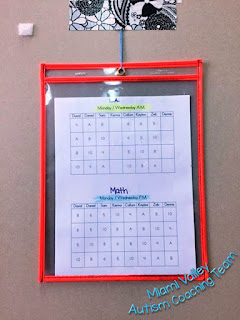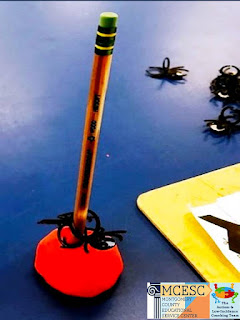This blog will focus on the important skill of putting forth effort. We often hear
from our teachers that a student has potential but does not put forth the
effort to do their best. The student may quickly rush through a task just to
get it done, without taking the time to do it right. This student may be lacking motivation. Or,
the student may be lacking important skills such as the ability to visualize
the outcome or the ability to persevere through a challenging task using their
inner coach.
We will share strategies for teaching students to put
forth effort using the Pillars of Performance (PoP) framework. PoP is a
framework we use to help students acquire and apply social skills. These
pillars include: PRACTICE, PRIME, PROMPT & PRAISE. We have
created a series of PoP cards to directly teach critical social
skills.
First, introduce the concept of effort with a
social narrative like the one below:
Social Narrative: Effort means you try hard to do something the best you can. Finishing a task is important, but it is also
important that you do a good job. When
you give someone your best effort, you show you care. A successful person knows
how to use effort to do quality work that makes them feel proud. Giving your best effort can be hard when the
task feels very difficult or really boring.
There are tricks you can use to make this happen. When you give your
best effort you will feel happy and proud!
Click the image below for a free handout of the Effort PoP card. Print, cut, and laminate the
card to use as a visual support when teaching this skill.
Let’s PRACTICE!
Practice
makes perfect. In order to master any skill, you need to deliberately practice
the skill. This makes it much easier to apply the skill in the moment when you
need it the most. Try some of these practice activities to strengthen skills.
Repeat, repeat, then repeat.
 Visualize- Help your student
practice the art of visualization. Teach your student to visualize the outcome
of the task. Provide them with a visual model or exemplar. Help them visualize
how they will feel when they are proud of their work. Talk about what that looks like. When you
create a visual representation of something, you activate parts of your brain
that help with motivation, awareness and creativity. That is why some of the
most successful athletes, artists and people practice visualization. To teach
the art of visualization, start with fun activities such as visualizing what
the best ice cream sundae would look like. Teachers often use visualizaton as a
strategy to help students with reading or story comprehension. One of the most
common ways to teach students how to visualize is to describe it as creating a
picture or movie in our mind. Encourage your student keep a positive mindset as
they visualize the future.
Visualize- Help your student
practice the art of visualization. Teach your student to visualize the outcome
of the task. Provide them with a visual model or exemplar. Help them visualize
how they will feel when they are proud of their work. Talk about what that looks like. When you
create a visual representation of something, you activate parts of your brain
that help with motivation, awareness and creativity. That is why some of the
most successful athletes, artists and people practice visualization. To teach
the art of visualization, start with fun activities such as visualizing what
the best ice cream sundae would look like. Teachers often use visualizaton as a
strategy to help students with reading or story comprehension. One of the most
common ways to teach students how to visualize is to describe it as creating a
picture or movie in our mind. Encourage your student keep a positive mindset as
they visualize the future.
 Push Yourself- Teach your
student to be his/her own coach. Teach the use of an inner dialogue. Create a
script they can say aloud or to themselves. If you hear your student making
negative comments, teach them to replace the negative thought with something
positive. To practice, identify a task that can be a trigger for frustration
such as math or writing. Set a visual
timer for 3 minutes. Ask the student to engage in the task for 3 minutes. The
student has to show genuine effort for 3 minutes. If the student stops trying
before the 3 minutes is up, the timer is reset. When the student is able to
show effort for 3 minutes the student gets a small reward. After a short break, set the timer again.
Gradually, the time can be increased. Click on the handout below to learn more
about replacing negative thoughts and creating a growth mindset.
Push Yourself- Teach your
student to be his/her own coach. Teach the use of an inner dialogue. Create a
script they can say aloud or to themselves. If you hear your student making
negative comments, teach them to replace the negative thought with something
positive. To practice, identify a task that can be a trigger for frustration
such as math or writing. Set a visual
timer for 3 minutes. Ask the student to engage in the task for 3 minutes. The
student has to show genuine effort for 3 minutes. If the student stops trying
before the 3 minutes is up, the timer is reset. When the student is able to
show effort for 3 minutes the student gets a small reward. After a short break, set the timer again.
Gradually, the time can be increased. Click on the handout below to learn more
about replacing negative thoughts and creating a growth mindset.
 |
Growth Mindset Bulletin Board
Jenna Woelfer
Brantwood Elementary, Mad River |
 Use a Calming Strategy- Help the student identify a quick in-the-moment
calming strategy such as deep breathing or palm presses. Practice this
regularly so it can be used when needed. By implementing this calming strategy
at the start of the task and as needed throughout the task, the student may be better able to stay calm and focus.
Here is one example of a calming strategy you can try:
Use a Calming Strategy- Help the student identify a quick in-the-moment
calming strategy such as deep breathing or palm presses. Practice this
regularly so it can be used when needed. By implementing this calming strategy
at the start of the task and as needed throughout the task, the student may be better able to stay calm and focus.
Here is one example of a calming strategy you can try:
 Quality Checklist- When the
main focus is finishing a task, it is easy to rush through without thinking
about quality. Create a quality checklist that breaks the task into small, sequential steps and includes quality
assurance steps such as check punctuation or check with the teacher. This provides structure for students with poor
executive function skills. By adding a preferred activity at the bottom of the
checklist you can motivate them to get through it.
Quality Checklist- When the
main focus is finishing a task, it is easy to rush through without thinking
about quality. Create a quality checklist that breaks the task into small, sequential steps and includes quality
assurance steps such as check punctuation or check with the teacher. This provides structure for students with poor
executive function skills. By adding a preferred activity at the bottom of the
checklist you can motivate them to get through it.
Time to
PRIME!

Use the priming bullets on the Effort card to review the strategies you
have practiced. What do they visualize happening when they are done? What
self-script can they use to coach themselves to do their best. If these
strategies are fresh in the mind of your student, the student is more likely to
apply the strategies. Make a point of reviewing these strategies prior to starting
a challenging or non-preferred task. Present the quality checklist with steps
needed for completion. Be sure to identify what will motivate the student to put
forth effort and write it at the bottom of the checklist. Next, have the
student engage in the calming strategy for a minute or more. These are all strategies that have been
practiced so the student should be very familiar with how to implement them.
The priming session should be a positive pep talk to review these strategies
and instill confidence in your student. If
the student does not like to talk about it, simply give them the card as a
visual reminder. By priming the student, you are setting them up for success.
PROMPT
Even with a priming session, the student may become
distracted or lose motivation while working on the task. Use the Effort card as an in-the-moment,
nonverbal prompt to get back to work. If the student is easily frustrated, prompt
or model the use of the calming strategy.
Consider other nonverbal prompts such as walking by
and tapping on the checklist, pointing to the specific step they should be
working. If they are unmotivated, point to the reward or positive comment written
at the bottom. Avoid engaging in verbal prompting as this may open the door for
off-topic conversation or argumentative behaviors.
Give PRAISE!
Our final pillar is the most important. We know that in
order to increase any skill we need to actively reinforce the skill. Any time you notice that the student is putting
forth their best effort on task, give them praise. Look for natural breaks to
give praise so that you don’t distract from the task. You can devise a subtle way to reinforce such
as giving thumbs up or a written note.
It will be important that you follow through with the reward that was written
at the bottom of the checklist. Facilitate intrinsic reinforcement for your
student by developing pride in their work and accomplishments. Some students
are motivated by adult approval while some older students may be more motivated
by peer approval. Determine what motivates your student to do their best. Here
is a Forced Choice Reinforcement Inventory to determine what reinforces your student:




That’s it! Those are the 4 pillars to teach your students
how to give their best effort. Each pillar is important in supporting the
application and generalization of this critical skill. Taking the time to
implement all 4 pillars will result in the outcome you want. It may take some
time so be patient and have fun with it. Teaching the skill with a positive
attitude will help the student develop a positive association with the
strategies. Developing your student’s confidence and ownership of the goal will
help your student succeed.



























































